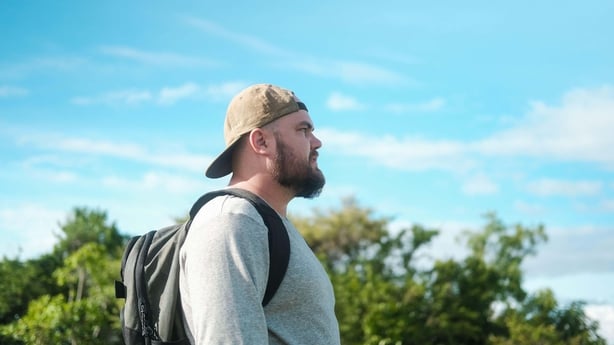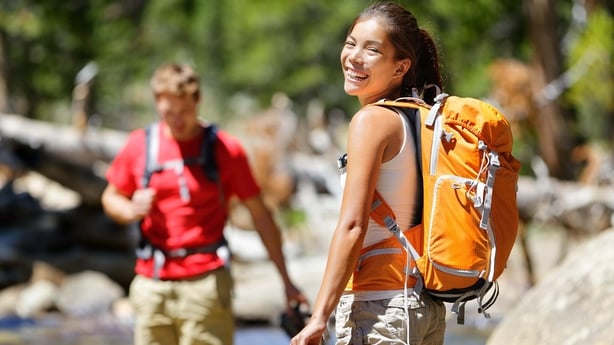When it comes to health and wellness benefits, it’s hard to beat the humble walk. It gets your blood pumping, clears your head, and if you’re lucky, gets you out into nature. But if you wanted to step things up and make it a more intense workout, get on the radar.
It basically means walking around with extra weight loaded, to make things more difficult. You can load a backpack or carrier with specially designed backpack plates, or opt for a weighted vest if you prefer.
There’s been growing growth on TikTok, and you’re likely to see a lot more of it this summer. So what do you need to know?
Where does rucking come from?
Rucking may be a trend, but it’s not new and has been part of military training for a long time. “We refer to it in the Royal Marines as yomping,” says Tommy Kelly, former Royal Marine commandant and co-founder of outdoor and mountain wear brand, Jttnar.
“It was a means of carrying heavy equipment, sometimes up to 120 pounds, over great distances and over difficult terrain. My shoulders, knees and back ached even though they hurt to think about it!”
Do you need specific equipment?
you don’t have to buy a dedicated bag or carrier and dishes to try it out. However, loading an ill-fitting backpack could lead to injury.
“Fit is important because backs come in all different shapes and sizes. An ill-fitting backpack, especially one with a heavy weight, will put excessive strain on your back and neck, likely leading to pain and injury ” says Kelly. “If possible, try on several options in a store, judging by fit and comfort. Most backpacks will have been tested by both online reviewers and customers, so there’s a wealth of information to help.”
He suggests looking for something with “a firm internal frame, as well as well-padded shoulder and waist straps,” plus “an integral chest strap is useful as a means of distributing weight as well.”
What are the benefits of fitness?
“You can be outside enjoying nature, while completing a higher intensity hike and improving your aerobic capacity or Vo2 max. [the max amount of oxygen your body can take in and use during exercise, often used as a measure for cardiorespiratory fitness]says Olivia Tyler, National Fitness Assurance Manager at Nuffield Health, who has just launched her #MyDailyMovement campaign, sharing a wealth of content and expert advice on new ways to get active in your web site
Tyler says it can also help improve balance, and of course, it’s strength training. “The ruck helps encourage better posture because you’re carrying weights on your back and you need to engage your core and back muscles,” he adds.
Kelly agrees that there are benefits to both “muscular and skeletal” strength. “A heavy load, carried routinely, forces the muscles and bones to adapt, that is, to strengthen,” he says, adding about the cardiovascular benefits: “The heart and lungs have to work hard rather than normal walking. Do it regularly and your fitness will improve significantly.”
Then there is the mental element. “Like anything difficult, done repeatedly, self-confidence and results strengthen the mindset,” says Kelly. “This is transferable to wider life.”
Any other tips for newbies?
Rucking may seem relatively simple, but you don’t want to go too heavy, too fast. “Start with a light load and shorter distances, and take it steadily to begin with,” says Kelly. “As strength and fitness improve, weight, distance and speed can be gradually increased.”

And remember, this is a workout, so it’s a good idea to warm up. “Warming up and then stretching is important for anything reasonably strenuous. A cold, unflexed body is much more susceptible to sudden physical stresses placed on it, so take five minutes to slowly raise your heart rate, mobilize your joints and stretch your muscles,” suggests Kelly.
Tyler says, “Make sure you’re walking the distances smoothly before you start adding weights to your route. Once you’re happy walking without weights, add weights gradually to avoid back injuries. The rucking it’s good for the back when done correctly, and when the weights are gradually increased over time,” he adds. “However, caution is required as injuries can occur when using the wrong backpacks, carrying too much weight on the shoulders and carrying backpacks on the back.
“I wouldn’t recommend weight vest training to anyone new to exercise or returning to exercise after some time off,” Tyler says. “It’s important to have a reasonably strong core and glutes, to support the extra weight without risking injury.
“I also wouldn’t recommend weight vests for anyone with certain back and neck problems such as spinal stenosis or disc degeneration. If you’re not sure, it’s always best to check with your GP or an exercise professional like a PT”.
#rucking #add #fitness #regimen
Image Source : www.rte.ie
